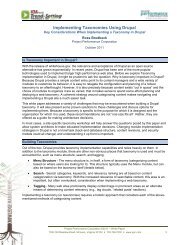(EIM) and Data Governance - PPC
(EIM) and Data Governance - PPC
(EIM) and Data Governance - PPC
You also want an ePaper? Increase the reach of your titles
YUMPU automatically turns print PDFs into web optimized ePapers that Google loves.
Enterprise Information Management <strong>and</strong><strong>Data</strong> <strong>Governance</strong>Mike Fleckenstein2. Enterprise Information Management/<strong>Governance</strong> Overview ________________<strong>EIM</strong>’s main functions are the collection of decision rights, processes, st<strong>and</strong>ards <strong>and</strong> policies required tomanage, maintain <strong>and</strong> exploit information as an enterprise resource. This can be achieved by theinteraction of an <strong>EIM</strong> Group (<strong>EIM</strong>G), <strong>Data</strong> <strong>Governance</strong> Council (DGC), the Services Bureau (SB) <strong>and</strong><strong>Data</strong> Stewards (DS).The DGC can be viewed as strategic in nature. Its main function is to regulate <strong>and</strong> prioritize competinginformation requests. The <strong>EIM</strong> Group’s main responsibility is to facilitate new data requests <strong>and</strong> requestsfor changes in data <strong>and</strong> to ensure that data is being maintained consistently enterprise-wide. The SB’sfunction is operational in nature. Its main mission is to implement the <strong>EIM</strong>G’s requests. Finally the DSare the individual gatekeepers for specific data. Their main role is to oversee the validation <strong>and</strong>dissemination a specific sub-set of data. Below is a summary of each body’s role <strong>and</strong> the interactionbetween these entities:The Enterprise Information Management Group (<strong>EIM</strong>G) is the central component to <strong>Data</strong> <strong>Governance</strong>.They are responsible for facilitating all data requests for new <strong>and</strong> changed data from the users (via theCustomer Services Group (CSG)). The <strong>EIM</strong>G works with the Services Bureau (SB) to obtain an estimatefor the requested work <strong>and</strong> provides this estimate back to the users (via CSG). Once funding isestablished the <strong>EIM</strong> Group ensures that the data request is architecturally sound. Their tasks include:• Brokering data requests for new <strong>and</strong> changed data from the users (via CSG);• Advising the <strong>Data</strong> <strong>Governance</strong> Council (DGC) on the priority of requests;• Chairing the DGC;• Assuring that data requests are met (i.e., owners of the data request);• Working with the Services Bureau (SB) to ensure that data requests are met in anarchitecturally sound way; <strong>and</strong>• Monitoring the information architecture to ensure that it is sound <strong>and</strong> advising the DGC onchanges <strong>and</strong> strategy.The Services Bureau (SB) is made up of Technical Staff members. There are two main components ofthe SB: the <strong>Data</strong> Services Bureau (DSB) <strong>and</strong> the Business Intelligence Service Bureau (BISB). The DSBfocuses on the actual data entering the Infrastructure <strong>Data</strong> Repositories <strong>and</strong> the BISB focuses on thedata consumption from Infrastructure <strong>Data</strong> Repositories data in the form of Reports, Dashboards,Scorecards, etc. The SB tasks include:• Executing the vision of the DGC <strong>and</strong> working with the <strong>EIM</strong> on how to best implement a givendata strategy;• Advising the <strong>EIM</strong>G on technical strategy <strong>and</strong> limitations related to data;• Assisting the <strong>EIM</strong>G, DGC <strong>and</strong> DS with data quality by running, monitoring <strong>and</strong> explainingdata profile reports;• Assuring a quality physical data architecture (DSB);• Guiding the business intelligence strategy (BISB); <strong>and</strong>• Developing the st<strong>and</strong>ard set of corporate reports requested by the DGC.The <strong>Data</strong> Stewards (DS) are subject matter experts (SMEs) from the business side. There are bothtactical as well as operational <strong>Data</strong> Stewards. While both are ‘gatekeepers’ for data completeness,st<strong>and</strong>ards <strong>and</strong> quality, tactical DS help set the guidelines while operational DS apply them on a day-to-www.ppc.com 2





